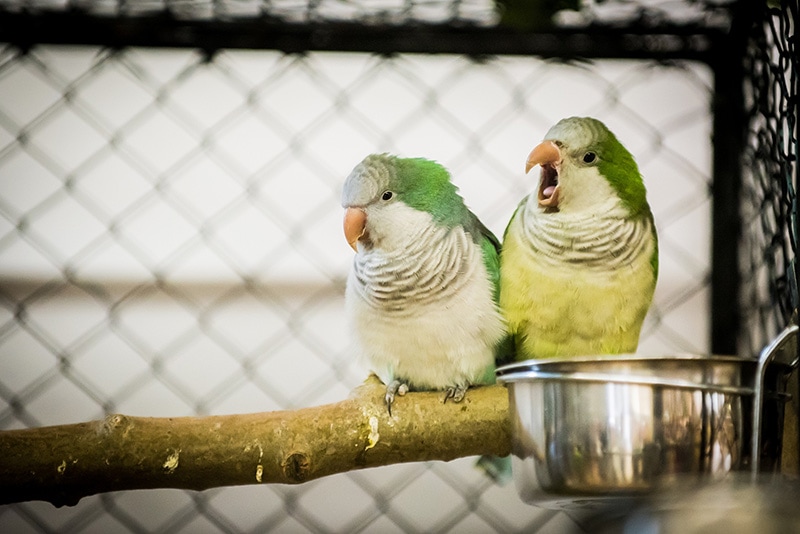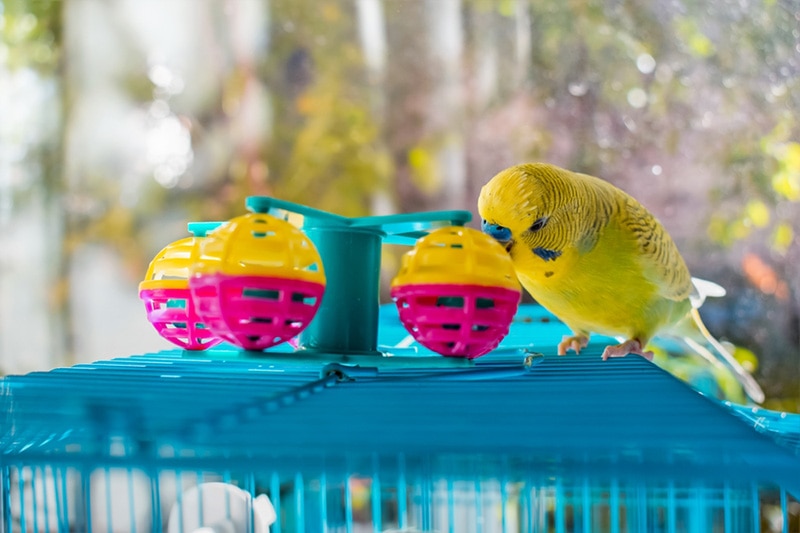Do Parakeets Like Mirrors? Facts & Care Tips

Updated on

Click to Skip Ahead
It’s not uncommon to see a mirror in a parakeet’s cage and because many owners have seen images of parakeets chattering to their mirrored friends, they follow suit and add a mirror themselves. They’re also very commonly found in pet stores and often even included as part of a parakeet cage set.
Unfortunately, despite your best intentions, putting a mirror in a parakeet’s cage can be harmful to the parakeet. It doesn’t recognize that the parakeet in the mirror is a reflection. This can lead some parakeets, especially those that live alone, to become obsessed with the other bird. It may cause your parakeet to try fighting with its reflection, and if it becomes obsessed with the mirror, it can cause a parakeet to neglect its feeding and other activities.
So, while letting your parakeet play with a mirror for a few minutes is unlikely to cause any harm, you shouldn’t leave one in their cage indefinitely.
The Problems with Mirrors
Although they are commonly used in parakeet cages, there are good reasons to avoid adding them to your setup, especially if you have a solo parakeet.
1. It Can Cause Aggression
Your bird will see its reflection in the mirror but is unlikely to recognize it as a reflection. Therefore, it will see the reflection as another bird in its cage. It’s the same as putting a brand new bird in the cage without proper introductions. And parakeets that have been living together for some time can still have moody moments where they fall out.
You might find your parakeet attacking the mirror and this can lead to injury and anxiety.

2. It Can Become Protective
Alternatively, if your parakeet doesn’t see the other bird as a threat, it might treat it as a friend or one of its flock. It may try to feed the reflection. This doesn’t mean simply passing seed, either, it could mean your parakeet will eat the food and then regurgitate it for the bird in the mirror. When the reflection doesn’t eat the food that has been offered, your parakeet may then choose to eat what it has regurgitated before trying again.
Continuously throwing up food and eating it can cause serious throat problems.
3. Your Parakeet Can Become Obsessed
It might seem amusing at first, seeing your bird trying to feed or attack the mirror. But, it can lead to obsession, especially if yours is a solo parakeet that has no other bird company. It may start to view the reflection as its mate and can even refuse to go anywhere or do anything without having its mate with it.
Your parakeet will stay by the mirror and refuse to exercise. It can even cause your ‘keet to stop eating.

Better Alternatives to Mirrors
So, mirrors are a bad addition to a parakeet cage, but there are alternatives that you can add to offer enrichment and improve the life of your bird. Instead of a mirror, consider adding the following to the cage:
1. Another Bird
Generally, parakeets are more likely to thrive when they are kept in pairs rather than on their own. These sociable birds live in large flocks in the wild, and while you don’t want 20 parakeets in a single cage in your home, having two means they can keep one another company and entertain themselves.
You can keep a male and female or two birds of the same gender. The only downside to keeping two parakeets is that they will not pay you as much attention as a sole parakeet would. But it is better for them.

2. Chew Toys
Parakeets love to chew and they especially enjoy chewing soft wood. Get some soft wood toys that hang from the cage. It will encourage good beak health, entertain your bird, and you get to watch them having fun.
3. Foraging Toys
Foraging toys encourage natural foraging behavior. In the wild, parakeets would have to forage for food so it is an instinctive action. Get some seeds as treats, put them in the foraging toy, and watch as it keeps your bird busy for hours.

4. Noisy Toys
Bells are another type of cage ornament that is included in packs and often seen in parakeet cages. But, unlike mirrors, they are considered healthy and beneficial for the birds. Just beware that if your parakeet really takes to the bell toy, the noise will be incessant.
5. A Bird Playground
A bird playground has multiple swings, ladders, and other elements. It is a great way to provide exercise for your bird while in the cage or when you let them out. You can even use the bird playground to help teach your parakeet a few tricks. They are intelligent birds and it is possible to train Parakeets to perform some basic commands.

Frequently Asked Questions
Should You Keep a Single Parakeet?
Parakeets are sociable birds that live in large flocks in the wild. In captivity, it is generally best to keep at least two birds together. Ensure the cage is big enough and that you introduce the birds slowly to prevent squabbling.
Should I Get Two Male Parakeets?
With some birds getting two males can be a bad idea. But parakeet males tend to get along well. They will usually preen one another, chatter to each other, and maybe even play games. It also prevents the chances of you ending up with a clutch of eggs.
Conclusion
Parakeets are sweet, intelligent birds. They can be taught tricks and some have very extensive vocabularies potentially consisting of hundreds of words. They are also sociable and benefit from being kept in pairs, rather than on their own. Avoid giving a solitary parakeet a mirror because it can lead to them becoming aggressive or obsessive, and there are much better options when it comes to toys and other ornaments for the cage.
Get a bell, if you can handle the noise, or a foraging toy to encourage natural behavior. Alternatively, get a second parakeet and make gradual introductions.
Featured Image Credit: photomaster, Shutterstock










